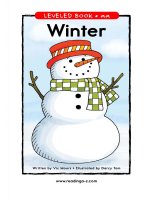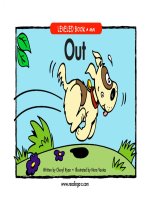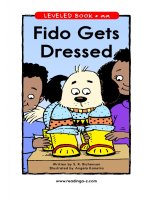raz lp05 musicinst
Bạn đang xem bản rút gọn của tài liệu. Xem và tải ngay bản đầy đủ của tài liệu tại đây (2.07 MB, 28 trang )
Musical Instruments
LEVELED BOOK • P
A Reading A–Z Level P Leveled Book
Word Count: 1,124
Written by Kira Freed
Visit www.readinga-z.com
for thousands of books and materials.
www.readinga-z.com
Written by Kira Freed
www.readinga-z.com
Table of Contents
Introduction.......................................... 4
Instruments........................................... 6
Orchestras............................................. 8
Bands.................................................. 16
Instruments Around the World............ 19
Glossary.............................................. 26
Musical Instruments • Level P
3
Table of Contents
Introduction.......................................... 4
Instruments........................................... 6
Orchestras............................................. 8
Bands.................................................. 16
Instruments Around the World............ 19
Glossary.............................................. 26
Frame drum with mallet
Introduction
Music has probably been important .
since the first humans lived on Earth.
They made musical instruments from
everyday objects. Music might have .
been discovered unintentionally .
when musical tones were created by
accidentally hitting a tree trunk or a
rock. Or the wind might have created
music when it blew through a shell, .
a reed, or a piece of bamboo.
Musical Instruments • Level P
3
4
Music is still important to us today. We
can make music with our voices or with
instruments. We can also dance to it or
just listen to it. Music brings pleasure
and joy to life. Gentle, quiet music
soothes us. Loud music excites us and
gives us energy. We can create or find
music to express all of our moods.
Taiko drummer (Japan)
Musical Instruments • Level P
5
Music is still important to us today. We
can make music with our voices or with
instruments. We can also dance to it or
just listen to it. Music brings pleasure
and joy to life. Gentle, quiet music
soothes us. Loud music excites us and
gives us energy. We can create or find
music to express all of our moods.
Instruments
Just as there are many types of music,
there are also many types of
instruments. Each
instrument has its own
special personality. Each .
one creates its own kind of
sound and mood. The sounds
can be soft, loud, gentle,
harsh, wild, or soothing.
Saxophone
Taiko drummer (Japan)
Musical Instruments • Level P
5
6
The type of sound made by .
a musical instrument depends .
on its shape, design, and size. .
The sound also depends .
on the materials from
which the instrument
is made and the way
it is played. It is truly
amazing how many
Mandolin (wood)
types of musical
instruments there are in the world..
Each one can bring pleasure .
to both the player .
and the listener.
Gong (metal)
Tambourine (skin)
Musical Instruments • Level P
7
Orchestras
The type of sound made by .
a musical instrument depends .
on its shape, design, and size. .
The sound also depends .
on the materials from
which the instrument
is made and the way
it is played. It is truly
amazing how many
Mandolin (wood)
types of musical
instruments there are in the world..
Each one can bring pleasure .
to both the player .
and the listener.
One place where many
musical
instruments
are found is
an orchestra.
This is a group of
musicians who play
together on certain musical
instruments. Most big .
cities, and many smaller
cities, have an orchestra.
Orchestras usually play
what is called classical
music.
Orchestral conductor
Gong (metal)
Tambourine (skin)
Musical Instruments • Level P
7
8
The biggest part of an orchestra .
is the string section. This
includes a family of stringed
instruments that are .
played with a bow.
These instruments all
create a similar kind of
Violin
sound, even though some .
are smaller with a higher sound .
and some are bigger with .
a deeper sound. The string
section includes violins,
violas, cellos, and double.
basses. The string.
section of a large.
orchestra can.
contain over.
seventy .
musicians.
Cello
Musical Instruments • Level P
Double bass
9
The biggest part of an orchestra .
is the string section. This
includes a family of stringed
instruments that are .
played with a bow.
These instruments all
create a similar kind of
Violin
sound, even though some .
are smaller with a higher sound .
and some are bigger with .
a deeper sound. The string
section includes violins,
violas, cellos, and double.
basses. The string.
section of a large.
orchestra can.
contain over.
seventy .
musicians.
Cello
Musical Instruments • Level P
Another stringed instrument in an
orchestra is plucked instead of bowed. .
It is the harp. It is a quieter .
instrument than many .
other orchestra .
instruments. .
The harp .
is usually .
played while .
fewer other .
instruments .
are playing .
so that it can be .
heard. Sometimes .
the harp is played .
solo, or alone.
Harp
Double bass
9
10
Another important group .
of instruments used by an
orchestra is the woodwind
family. The woodwinds
include flutes, oboes,
clarinets, and bassoons. .
The woodwinds have other
family members that may .
be part of an orchestra, .
too. The flute has a
smaller cousin, called .
a piccolo. The other
woodwinds have
bigger cousins called
the English horn,
bass clarinet, .
and double
bassoon.
Flute
Musical Instruments • Level P
11
Woodwind instruments are
played by blowing air into
them. They have many
holes that make different
musical notes when the
holes are covered or
uncovered. Sometimes
the holes are covered
by the player’s fingers.
Sometimes the player
holds down keys .
that cover the holes.
Another important group .
of instruments used by an
orchestra is the woodwind
family. The woodwinds
include flutes, oboes,
clarinets, and bassoons. .
The woodwinds have other
family members that may .
be part of an orchestra, .
too. The flute has a
smaller cousin, called .
a piccolo. The other
woodwinds have
bigger cousins called
the English horn,
bass clarinet, .
and double
bassoon.
Flute
Musical Instruments • Level P
Clarinet
11
12
French horn
Another section of the orchestra is the
brass section. This includes trumpets,
horns, trombones, and tubas. These are
among the most powerful instruments .
in an orchestra. Brass instruments, like
woodwinds, are played by blowing into
them. Trumpets, horns, and tubas have
valves that a player pushes to change
notes. Trombones have a U-shaped metal
tube and slide. The player moves the
slide to change notes.
Musical Instruments • Level P
13
French horn
Another section of the orchestra is the
brass section. This includes trumpets,
horns, trombones, and tubas. These are
among the most powerful instruments .
in an orchestra. Brass instruments, like
woodwinds, are played by blowing into
them. Trumpets, horns, and tubas have
valves that a player pushes to change
notes. Trombones have a U-shaped metal
tube and slide. The player moves the
slide to change notes.
Musical Instruments • Level P
13
Percussion instruments are another
important part of an orchestra. These
instruments are all struck, or hit, in .
one way or another. They are made of
skin, metal, or wood. Some percussion
instruments, such as a xylophone, .
create musical notes. Others, such as
castanets and most drums, create .
sound with no musical notes. .
Percussion adds .
bangs and .
splashes .
to the sound .
of an orchestra.
Kettledrum
14
Keyboard instruments include the piano
and organ. These instruments have
closed cases that hide the inside of the
instrument. Pianos have strings that
vibrate. Organs create sound by .
the use of wind. These instruments .
all have many keys that .
can create many .
more notes than .
most other .
instruments.
Baby grand piano
Musical Instruments • Level P
15
Keyboard instruments include the piano
and organ. These instruments have
closed cases that hide the inside of the
instrument. Pianos have strings that
vibrate. Organs create sound by .
the use of wind. These instruments .
all have many keys that .
can create many .
more notes than .
most other .
instruments.
Baby grand piano
Musical Instruments • Level P
Bands
Bands are another kind of musical .
group that have their own kinds
of instruments. Marching bands
use brass, woodwind, and
percussion instruments, but .
no strings. There are many
other kinds of bands as well.
They often include one .
or more guitars, another
stringed instrument. .
Guitars are the
foundation of .
many bands in the
same way that the
violin family is the
foundation of an
orchestra. Guitars
played in bands
are often made
louder by the use
of amplifiers.
Electric guitar
15
16
A rock band can include electric guitars,
bass guitars, drums, and an electronic
keyboard, along with other instruments.
A jazz band can have many of the same
instruments as a rock band. It can also
have woodwinds and brass instruments.
Latin bands often have extra percussion
such as the marimba, an instrument
related to a xylophone.
Marimba
Musical Instruments • Level P
17
A rock band can include electric guitars,
bass guitars, drums, and an electronic
keyboard, along with other instruments.
A jazz band can have many of the same
instruments as a rock band. It can also
have woodwinds and brass instruments.
Latin bands often have extra percussion
such as the marimba, an instrument
related to a xylophone.
Bluegrass and country music bands may
have guitars, banjos, mandolins, and
autoharps. They may also have .
various percussion instruments .
such as spoons, washboards, .
and bucket basses. These .
bands also have fiddles, .
which are violins played .
in a very different style .
than they are in an .
orchestra.
Marimba
Musical Instruments • Level P
Five-string banjo
17
18
Kalimba, or thumb piano (Africa)
Instruments Around the World
Cultures around the world have
instruments that are very different from
the ones described so far in this book.
But most instruments, no matter where
they are found, are played in one of four
ways—by blowing, scraping, plucking, .
or hammering. Some examples of each
type of instrument are shown on the
following pages.
Musical Instruments • Level P
19
Blown instruments, including .
the woodwinds, all force .
air down a tube. Look at .
these photographs of .
blown instruments .
from around .
the world.
Native American flute
Kalimba, or thumb piano (Africa)
Instruments Around the World
Cultures around the world have
instruments that are very different from
the ones described so far in this book.
But most instruments, no matter where
they are found, are played in one of four
ways—by blowing, scraping, plucking, .
or hammering. Some examples of each
type of instrument are shown on the
following pages.
Musical Instruments • Level P
19
Scottish bagpipes (Scotland)
Panpipes (Greece, Latin America, Far East)
20
Scraped instruments include the violin
family. They often use a bow that creates
sound when scraped over strings. But
many scraped
instruments
create music .
in other ways.
These are .
two unusual
scraped
instruments.
Gusle
(Eastern Europe)
Hurdy-gurdy (Europe)
Musical Instruments • Level P
21
Scraped instruments include the violin
family. They often use a bow that creates
sound when scraped over strings. But
many scraped
instruments
create music .
in other ways.
These are .
two unusual
scraped
instruments.
Plucked instruments have strings that
can be plucked using fingers or a variety
of other objects. Here are .
some plucked instruments .
from around the world.
Gusle
(Eastern Europe)
Lute (Middle East, Europe)
Koto ( Japan)
Sitar (India)
Hurdy-gurdy (Europe)
Musical Instruments • Level P
21
22
Hammered instruments include drums
and other percussion instruments. .
They create music by hitting .
one object with .
another. Cultures.
around the world .
have many kinds .
of hammered.
instruments. Here .
are a few of them.
Drum (Africa)
Shekere, or beaded gourd
shaker (Africa)
Castanets (Spain)
Musical Instruments • Level P
23
In many ways, the human voice can .
be considered a musical instrument. .
It is perhaps the most flexible musical
instrument of all. It can create and sing
songs with words, tunes without words,
and a wide variety of rhythms and
sounds. It doesn’t cost anything since no
extra equipment is needed. If you are in
a place where you need to be quiet, you
can still hum or sing silently to yourself.
Hammered instruments include drums
and other percussion instruments. .
They create music by hitting .
one object with .
another. Cultures.
around the world .
have many kinds .
of hammered.
instruments. Here .
are a few of them.
Barbershop
quartet
Drum (Africa)
Shekere, or beaded gourd
shaker (Africa)
Castanets (Spain)
Musical Instruments • Level P
23
24
Music brings great joy to life. It helps .
us to express ourselves, and it fills .
our world with beauty. .
Whether you sing, dance, .
play an instrument, .
or sit and listen .
to music, .
be sure .
to make it .
a part of .
your life.
Saxophone player
Musical Instruments • Level P
25









